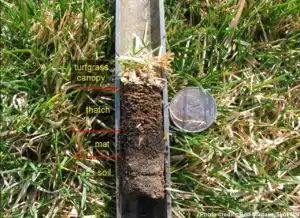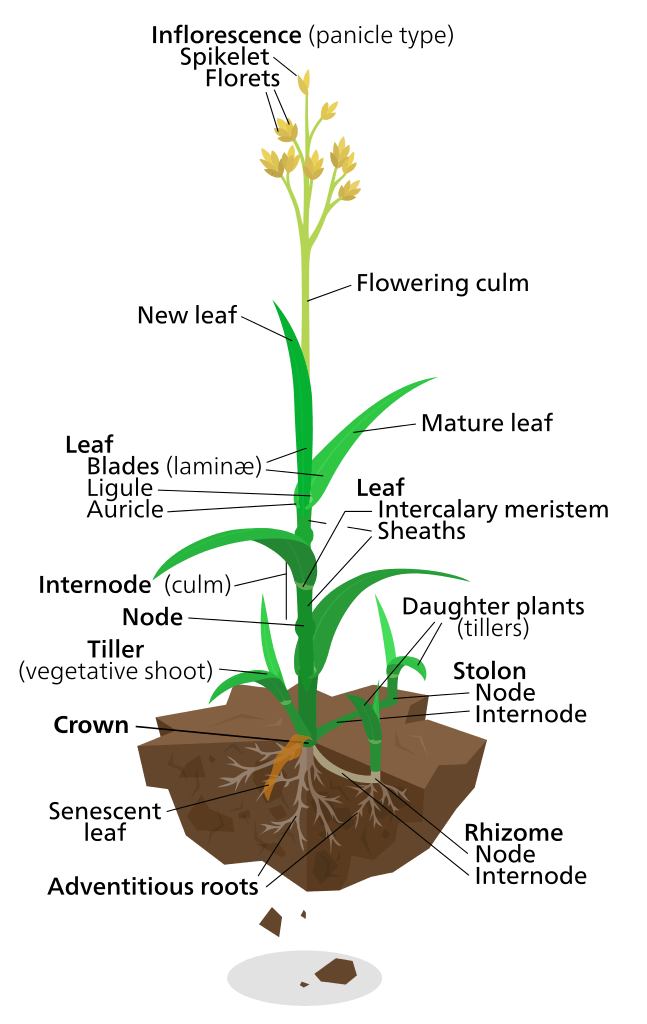Click here to jump to product recommendations, advice about effectively aerating your lawn or a short description of the differences between common models on the market.
Aeration is a necessary part of any effective lawn care regimen – whether it’s carried out over the space of an acre or a single backyard. Thatch, compacted and nutrient-depleted soil, and weak, poorly-rooting grass are all problems that can be remedied with proper aeration. Choosing the best lawn aerator possible will also go a long way in making sure you get optimal results.
This article is in two parts. I’ve selected five of my favourite aerators and they’re listed in the second half. The first part of the article is a crash course in soil aeration
I also take a look at the ways in which various models (electric, manual, sandals, rollers etc.) differ towards the end.
Let’s dive in…
What is aeration?
Aeration involves perforating turf with small holes that are each a few inches deep. Usually, the soil from the holes (called plugs) is removed and left on the top of the lawn. Alternatively aeration spikes can be pressed into the ground without unearthing any soil.
Why does your lawn need aerating?

There are two main reasons for aeration: to break through the thatch barrier and to improve the circulation of air, water and nutrients in compacted soil.
Thatch (explained below) hinders the flow of nutrients and water beyond the surface of the lawn whilst compaction prevents the movement of air and water (both essential for healthy plants) through the small pores in soil. An absence of air pockets (called macropores) means that both air and water cannot flow freely. Compaction also hinders proper rooting because it’s difficult for plants to penetrate packed-down earth.
What is thatch?

Thatch is a layer of both dead and living plant material (essentially live and decaying roots) that lies below the surface greenery and above the surface of the soil.
When grass plants die their roots (crowns) begin to decompose and this accumulated organic matter is what can eventually cause a thick impenetrable thatch through which water and nutrients struggle to pass. Ultimately bad thatch will also hinder the growth of healthy new grass because seed will effectively be germinating in the thatch layer.
When does your lawn need aerating?
Any lawn will benefit from aeration. It will lead to an increase the presence of nutrients in the topsoil and improve the flow and distribution of air and water. That said, there are a handful of circumstances in which it’s particularly important to aerate your lawn regularly, for instance:
- If your lawn receives heavy footfall, particularly if it’s used for sports or events.
- If your house is new. In many instances the soil surrounding new-builds is very poor. During the course of building, the ground is churned up, destroying the topsoil in the process. Because of this, it’s vital that you do everything you can to improve the health of your lawn.
- If your lawn has recently been lain. If you have recently put down sod (strips of grass or turf) then aerating will help blend the fine “sod soil” with the topsoil underneath.
- If your lawn is prone to dryness or waterlogging. In both cases aerating will help.
Usually, the best time to aerate is during the growing season (late spring to early autumn) when your lawn is slightly wet. Aerating during the warmer, brighter months will mean that your grass has time to repair itself and fill in the plugged gaps.
It’s also worth going over the heavily-compacted parts of your lawn a few times. Leave plugs to dry out and then pass over them with a lawn mower or rake to break them up.
You have a few options when it comes to picking a lawn aerator. Let’s have a look at some of them…
Our top 5 picks (US & UK selections)…
***Full Disclosure – Where appropriate, I’ve linked product images to commercial sites. If you buy from these sites, I earn a small affiliate fee, which helps me keep Urban Turnip going.***
Nylon Spiked Aeration Sandals (Gardenite) (UK and US)
[easyazon_image align=”none” height=”1500″ identifier=”B01ER202S6″ locale=”US” src=”https://www.urbanturnip.org/wp-content/uploads/2016/11/71QJ2sFbuL.jpg” tag=”urbanturnip-20″ width=”564″]
Aeration sandals can be a bit hit and miss. Though they’re often a great option for gardeners because they’re inexpensive and easy-to-use, their quality can be poor. This pair of sandals from Gardenite, however, ticks all the boxes as far as quality and functionality are concerned.
To start off with, the “soles” are made from nylon, which is much stronger than the plastic usually used to make aeration sandals. The straps are fastened with zinc buckles (again, not plastic) and there are four of them, as opposed to the usual three. Spare spikes and a wrench are included and there’s also a money-back guarantee (no questions asked).
Agri-Fab 48-Inch Plug Aerator (UK and US)
[easyazon_image align=”none” height=”768″ identifier=”B000K6DZDI” locale=”US” src=”https://www.urbanturnip.org/wp-content/uploads/2016/12/716BbVzwpbL.jpg” tag=”urbanturnip-20″ width=”564″]
If you’re looking after a larger lawn, then a more sophisticated aerator may be required. The Agri-Fab 48-Inch Plug Aerator is made with 8 spools, each with 4 galvanised steel spikes. The idea is to use the (48-inch long) tray to weigh down the spikes so that they better penetrate the soil. A breeze block would be ideal.
You will obviously need a tractor lawnmower to pull it. One complaint is that the lever for lifting and lowering the spools can’t be reached from a sitting position. The tyres are pneumatic, so you won’t need to worry too much about getting a permanent flat. If you’re working on an area above a few acres, then “industrial level” equipment will probably be needed.
Fiskars Coring Aerator (Plug) (US)
[easyazon_image align=”none” height=”1000″ identifier=”B01E5RUEEU” locale=”US” src=”https://www.urbanturnip.org/wp-content/uploads/2016/12/51G8VimR0EL-1.jpg” tag=”urbanturnip-20″ width=”564″]
A human-powered model like this one will be the best option for those aerating smaller areas of grass. The 4-inch steel prongs remove a circular chunk of earth (as opposed to the spike aerators which simply press holes into the ground) which can then be left on the surface of the lawn (each step pushes the previous step’s “cores” out). Both the T-handle and the central platform for pressing the prongs into the soil are very robust and will work well on even the most compacted soils. The model as a whole is also strikingly light.
I’ve included the two-pack here because it represents the best value for money. Single units are also available.
Kingfisher Plug Lawn Aerator (UK)
[easyazon_image align=”none” height=”500″ identifier=”B0060LSEQU” locale=”UK” src=”https://www.urbanturnip.org/wp-content/uploads/2016/12/41R6F1bQ2nL.jpg” tag=”urbanturnip-20″ width=”564″]
With five individual coring prongs, the Kingfisher Plug Aerator is a great manual option for small lawns. It’s a well-built and strong tool and the 6-inch or so tines are very effective. Like the previous Fiskars model, each step pushes out the cores from the previous one. As long as you’re aerating after rain, you shouldn’t have any trouble using this tool on even the hardest of clay soils. Another good thing about it is that the prongs aren’t overly wide, so the “damage” to your lawn will appear minimal.
The handle doesn’t have any extra padding, so if you’re prone to blisters, you might want to consider covering it in some padding.
Agri-Fab Rolling Spike Aerator (US)
[easyazon_image align=”none” height=”500″ identifier=”B0007VTQRK” locale=”US” src=”https://www.urbanturnip.org/wp-content/uploads/2016/12/Agri-fab-lawn-1.png” tag=”urbanturnip-20″ width=”564″]
For the final entry, I’ve picked a medium-power manual aerator that sits between sandals and tractor-pulled machinery on the power spectrum. It’s a push aerator with 5 wheels each consisting of seven spokes. The central platform, much as with the tractor-pulled model by the same company, is meant to hold a weight of some kind (a breeze block is ideal) so as to push the spokes into the ground.
It comes with a 3-year warranty and is easy to assemble. For the price, this is a great piece of kit. Generally speaking, plug aerators are better for lawns, but if you’re after a quick solution, then this rolling aerator will happily do the job!
Spikes vs. Plugs
OK, so onto the difference between spikes and plugs.
A spike aerator is a spiked tool (you guessed it) used to push holes in the ground. Sandals are a perfect example. The spikes (or tines) themselves are solid (unlike plugs) and don’t remove any soil from the ground. Rather, they compact it to the sides.
A plug aerator works in exactly the same way as a spike aerator, the only difference being that the tool removes a “plug” of soil from the lawn. They tend to be the better option because they don’t cause the same kind of compaction that spike aerators do.
Rollers vs. Sandals
If you’re going for spikes, which are the quicker option, then you can choose between rollers or sandals. The idea behind sandals is that you attach a spiked platform to your shoes and walk around the garden. The main benefit is that they’re inexpensive and it’s easy to pass over the heavily-compacted areas several times.
Rollers work on the same principle, just with spikes attached to a drum that is pushed in the same way as a lawn mower. The main thing to check for when buying a roller is that the drum is heavy enough to force the spikes into the ground, particularly if you’ve got hard clay soil.
Whats the difference between an aerator and a scarifier?
One last point. Don’t confuse a scarifier with an aerator – both have different uses. Where, as has as already been explained, aerators pierce the surface of the lawn to improve drainage and aeration, scarifiers are used to remove thatch.
A scarifier uses spikes (or tines) to pull thatch and moss from the surface of a lawn, rather than dig holes into it. Ideally, scarification and aeration should be done in conjunction.
What are your thoughts? Leave a comment below!
So there you have it – my best picks and advice about choosing a lawn aerator! What are your thoughts? Have you used the products I’ve reviewed? Or do you have your own favourites? Leave a comment in the comments section below.